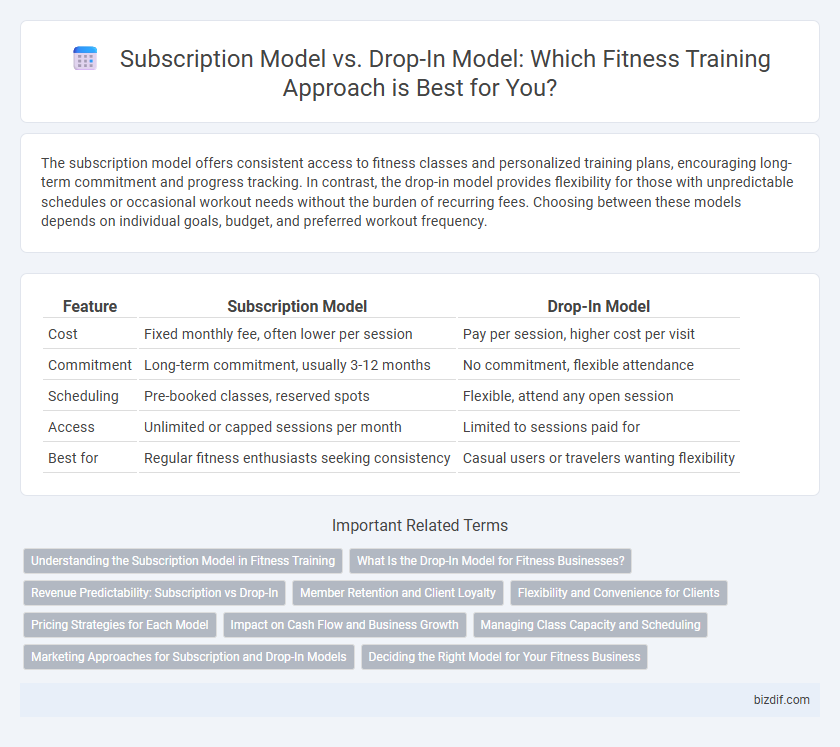The subscription model offers consistent access to fitness classes and personalized training plans, encouraging long-term commitment and progress tracking. In contrast, the drop-in model provides flexibility for those with unpredictable schedules or occasional workout needs without the burden of recurring fees. Choosing between these models depends on individual goals, budget, and preferred workout frequency.
Table of Comparison
| Feature | Subscription Model | Drop-In Model |
|---|---|---|
| Cost | Fixed monthly fee, often lower per session | Pay per session, higher cost per visit |
| Commitment | Long-term commitment, usually 3-12 months | No commitment, flexible attendance |
| Scheduling | Pre-booked classes, reserved spots | Flexible, attend any open session |
| Access | Unlimited or capped sessions per month | Limited to sessions paid for |
| Best for | Regular fitness enthusiasts seeking consistency | Casual users or travelers wanting flexibility |
Understanding the Subscription Model in Fitness Training
The subscription model in fitness training offers members unlimited or recurring access to classes and facilities for a fixed monthly or annual fee, promoting consistent engagement and long-term commitment. This model often includes personalized workout plans, progress tracking, and exclusive member benefits, enhancing the overall value and motivation for users. By providing predictable revenue streams for fitness centers, the subscription model supports sustainable business growth and continuous service improvements.
What Is the Drop-In Model for Fitness Businesses?
The Drop-In Model for fitness businesses allows clients to pay per visit without committing to long-term contracts, providing flexibility and convenience for users with unpredictable schedules. This model attracts casual gym-goers and tourists seeking short-term access to workout facilities and classes. Fitness centers benefit from increased foot traffic and the ability to offer diverse pricing options tailored to varying customer needs.
Revenue Predictability: Subscription vs Drop-In
Subscription models in fitness training provide predictable monthly revenue streams by securing consistent payments from members, enhancing cash flow management and financial planning. Drop-in models rely on individual visit fees, resulting in fluctuating income that can hinder stable revenue forecasting and budget allocation. Gyms prioritizing growth and sustainability often favor subscriptions for their ability to generate steady, recurring revenue.
Member Retention and Client Loyalty
Subscription models in fitness training foster higher member retention by offering consistent access and incentivizing long-term commitment, leading to increased client loyalty through personalized progress tracking and community engagement. Drop-in models provide flexibility but often result in lower retention rates due to the lack of structured engagement and less emotional investment. Training facilities leveraging subscription plans typically see enhanced lifetime value per client and stronger brand allegiance.
Flexibility and Convenience for Clients
The Subscription Model offers consistent access to fitness classes, allowing clients to plan regular workouts and benefit from structured progress tracking. The Drop-In Model provides ultimate flexibility, enabling clients to attend sessions sporadically without long-term commitments or prepaid packages. Both models cater to different lifestyles, with subscriptions suited for routine-focused individuals and drop-ins ideal for those seeking convenience and spontaneity.
Pricing Strategies for Each Model
Subscription models in fitness training often use tiered pricing strategies with monthly or annual fees, offering members discounted rates and added value through unlimited classes or exclusive content. Drop-in models employ flexible, pay-per-session pricing, ideal for clients seeking occasional workouts without long-term commitments, often charging higher per-class rates to offset variable attendance. Both approaches balance revenue stability and accessibility, with subscriptions encouraging customer loyalty and drop-ins attracting a broader, less predictable audience.
Impact on Cash Flow and Business Growth
The Subscription Model provides predictable cash flow through recurring payments, enabling steady revenue that supports long-term business growth and resource planning. The Drop-In Model generates variable income, leading to fluctuating cash flow that may challenge consistent financial stability but attracts a broader customer base with flexible commitments. Fitness centers employing subscriptions often experience higher customer retention and more reliable financial forecasting compared to those relying primarily on drop-in sales.
Managing Class Capacity and Scheduling
Subscription models enable fitness centers to predict class attendance and manage capacity efficiently by analyzing member commitment patterns, ensuring optimal resource allocation. Drop-in models offer flexibility but often result in unpredictable class sizes, making it challenging to maintain balanced scheduling and avoid overcrowding. Effective management of class capacity relies on data-driven forecasting tools that align with the chosen model to maximize participant experience and operational efficiency.
Marketing Approaches for Subscription and Drop-In Models
Subscription models in fitness training utilize targeted digital marketing campaigns emphasizing long-term commitment and value through exclusive content, personalized coaching, and consistent progress tracking. Drop-in models leverage localized advertising and social media promotions highlighting flexibility, convenience, and no commitment, effectively attracting casual or transient gym users. Data analytics and customer segmentation optimize both approaches by tailoring messaging to specific demographics, enhancing conversion rates and member retention.
Deciding the Right Model for Your Fitness Business
Choosing between a subscription model and a drop-in model for your fitness business hinges on analyzing customer commitment patterns and cash flow stability; subscription models provide predictable revenue by encouraging long-term member engagement, while drop-in models appeal to clients seeking flexibility and occasional visits. Evaluating target demographics, competition, and pricing sensitivity helps tailor the approach, with hybrid models increasingly popular to balance steady income and client convenience. Implementing data analytics on attendance and retention rates further refines decision-making to optimize profitability and customer satisfaction.
Subscription Model vs Drop-In Model Infographic

 bizdif.com
bizdif.com